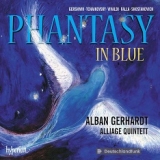Orchesterwerke mit dem solistischen Cello für ein Quintett mit Cello, vier Saxophonen und Klavier zu transkribieren mag auf Anhieb eher absonderlich und vielleicht sogar unnötig erscheinen. Skurril sind solche Unternehmungen immer dann, wenn das Resultat klanglich irritierend ist, und unnötig, wenn aus der Transkription kein Mehrwert entsteht. Beides ist hier nicht der Fall. Das Klangergebnis ist vom Feinsten und der Mehrwert ist nicht einmal nur im reduzierten Satz vorhanden, sondern vollwertig.
In Tchaikovskys Rokokovariationen hört man neue Farben – hinreißend der Bluescharakter im Andante der 6. Variation – , neue Akzente und etwas, was ich, zumindest bis zum unbändigen, superquirligen Finale viel schöner finde, eine neue Intimität des Ausdrucks, die den Hörer tief berührt.
Diesen Grad an Besonderheit erlangt das Vivaldi-Konzert nicht, aber das Stück ist eigentlich auch so ganz nett.
Sehr interessant ist auch die Transkription der Siete canciones populares espanolas, deren farbenprächtige, aber auch treue Bilder spanischen Volkslebens sehr eindringlich werden. Das Cello ist besonders gut geeignet, um den einzigartigen Charakter dieser spanischen Lieder wiederzugeben, aber der Bearbeiter hat als begnadeter musikalischer Alchimist den Gesangspart nicht losgelöst hat von der Begleitung, sondern beide Parts in einem neuen Ganzen vermischt, das die Canciones viel reicher werden lässt. Es sind keine Lieder mehr, sondern Szenen, die vor dem musikalischen Augenohr entstehen.
Nach drei exquisiten kurzen Stücken von Shostakovich beschließen die Alliages und Alban Gerhardt das Programm mit einer Phantasie über Gershwins Rhapsody in Blue. Auch sie zeugt von einer künstlerisch sehr anspruchsvollen und einfallsreichen Beschäftigung mit dem Urgestein, die zu einer ungemein spannenden und hoch intensiven Darbietung führt.
Wild geht es darin manchmal zu, mit bacchischem Taumel und berserkerhaftem Antrieb sowie, dazwischen, wunderbaren Tönen tiefster, zartester Empfindung oder tiefer Melancholie. Das ist eine richtige Novität, gespielt von eminenten Talenten. Alban Gerhardt zeigt also brillant, wie sinnvoll es ist, wenn ein Cello mit Saxophonen ‘fremdgeht’.
Transcribing orchestral works with the solo cello for a quintet with cello, four saxophones and piano may at first seem rather outlandish and perhaps even unnecessary. Such undertakings are always bizarre when the result is sonically irritating, and unnecessary when no added value arises from the transcription. Neither is the case here. The sound result is of the finest and the added value is not even present only in the reduced but in the highest rate.
In Tchaikovsky’s Rococo Variations one hears new colors – ravishing the blues character in the Andante of the 6th variation – , new accents, and something I find much more beautiful, at least until the unruly, superquirky finale, a new intimacy of expression that touches the listener deeply.
The Vivaldi concerto does not attain this degree of specialness, but the piece is actually quite nice as it is.
The transcription of the Siete canciones populares espanolas is also very interesting, its colorful but also faithful images of Spanish folk life becoming very vivid. The cello is particularly well suited to render the unique character of these Spanish songs, but the arranger, as a gifted musical alchemist, has not detached the vocal part from the accompaniment, but has blended both parts into a new whole that makes the canciones much richer. They are no longer songs, but scenes that emerge before the musical ear.
After three exquisite short pieces by Shostakovich, the Alliages and Alban Gerhardt conclude the program with a fantasy on Gershwin’s Rhapsody in Blue. It, too, testifies to an artistically very demanding and imaginative preoccupation with the primeval rock, which leads to an immensely exciting and highly intense performance.
It is wild at times, with Bacchic frenzy and berserk drive as well as, in between, wonderful tones of deepest, most tender feeling or deep melancholy. This is a real novelty, played by eminent talents. So Alban Gerhardt brilliantly shows how useful it is when a cello ‘cheats’ with saxophones.






















